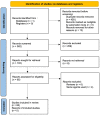The Present and the Future of Medical Therapies for Adenomyosis: A Narrative Review
- PMID: 37834773
- PMCID: PMC10573655
- DOI: 10.3390/jcm12196130
The Present and the Future of Medical Therapies for Adenomyosis: A Narrative Review
Abstract
Uterine Adenomyosis is a benign condition characterized by the presence of endometrium-like epithelial and stromal tissue in the myometrium. Several medical treatments have been proposed, but still, no guidelines directing the management of adenomyosis are available. While a hysterectomy is typically regarded as the definitive treatment for adenomyosis, the scarcity of high-quality data leaves patients desiring fertility with limited conservative options. Based on the available data, the levonorgestrel-IUD appears to offer the most favorable outcomes. Other treatments, including GnRH antagonists, dienogest, prolactin, and oxytocin modulators, show promise; however, further data are required to establish their efficacy definitively. Furthermore, there are many emerging therapies that have been developed that seem worthy of consideration in the near future. The aim of this narrative review was to explore the current medical treatments available for adenomyosis and to provide a glimpse of future therapies under assessment. For this scope, we performed a literature search on PubMed and Medline from incept to September 2022 using the keywords: "medical treatment", "non-steroidal anti-inflammatory", "progesterone intrauterine device", "dienogest", "combined oral contraceptives", "gonadotropin releasing hormone agonist", "gonadotropin releasing hormone antagonist", "danazol", "aromatase inhibitors", "ulipristal acetate", "anti-platelet therapy", "dopamine", "oxytocin antagonists", "STAT3", "KRAS", "MAPK", "micro-RNA", "mifepristone", "valproic acid", "levo-tetrahydropalamatine", and "andrographolide". The search was limited to articles in English, with subsequent screening of abstracts. Abstracts were screened to select relevant studies.
Keywords: adenomyosis; gonadotropin releasing hormones; intrauterine devices; medical treatments; progesterone.
Conflict of interest statement
The authors declare no conflict of interest.
Figures


References
-
- Akira S., Mine K., Kuwabara Y., Takeshita T. Efficacy of long-term, low-dose gonadotropin-releasing hormone agonist therapy (draw-back therapy) for adenomyosis. Med. Sci. Monit. 2008;15:CR1–CR4. - PubMed
-
- Andersson J.K., Mucelli R.P., Epstein E., Stewart E.A., Gemzell-Danielsson K. Vaginal bromocriptine for treatment of adenomyosis: Impact on magnetic resonance imaging and transvaginal ultrasound. Eur. J. Obstet. Gynecol. Reprod. Biol. 2020;254:38–43. doi: 10.1016/j.ejogrb.2020.08.040. - DOI - PubMed
Publication types
LinkOut - more resources
Full Text Sources
Miscellaneous

